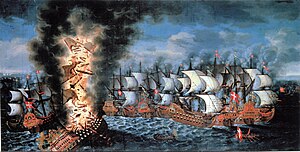Battle of Öland
| Battle of Öland | |||||||
|---|---|---|---|---|---|---|---|
| Part of the Scanian War | |||||||
 Oil painting by Claus Møinichen showing how Kronan founders and explodes, while Svärdet is surrounded by the allied admirals |
|||||||
|
|||||||
| Belligerents | |||||||
|
|
|
||||||
| Commanders and leaders | |||||||
|
|
|
||||||
| Strength | |||||||
| 42 warships, including 25 ships of the line | 57 warships, including 27 ships of the line c. 12,000 men |
||||||
| Casualties and losses | |||||||
| 1 fireship at least 100 dead |
5 ships sunk 6 ships captured at least 1,400 dead |
||||||
The Battle of Öland was a naval battle between an allied Danish-Dutch fleet and the Swedish navy in the Baltic Sea, off the east coast of Öland on 1 June 1676. The battle was a part of the Scanian War (1675–79) fought for supremacy over the southern Baltic. Sweden was in urgent need of reinforcements for its north German possessions; Denmark sought to ferry an army to Scania in southern Sweden to open a front on Swedish soil.
Just as the battle began, the Swedish flagship Kronan sank, taking with it almost the entire crew, including the Admiral of the Realm and commander of the Swedish navy, Lorentz Creutz. The allied force under the leadership of the Dutch admiral Cornelis Tromp took full advantage of the ensuing disorder on the Swedish side. The acting commander after Creutz's sudden demise, Admiral Claes Uggla, was surrounded and his flagship Svärdet battered in a drawn-out artillery duel, then set ablaze by a fire ship. Uggla drowned while escaping the burning ship, and with the loss of a second supreme commander, the rest of the Swedish fleet fled in disorder.
The battle resulted in Danish naval supremacy, which was upheld throughout the war. The Danish King Christian V was able to ship troops over to the Swedish side of the Sound, and on 29 June a force of 14,500 men landed at Råå, just south of Helsingborg in southernmost Sweden. Scania became the main battleground of the war, culminating with the bloody battles of Lund, Halmstad and Landskrona. Danish and Dutch naval forces were left free to raze Öland and the Swedish east coast all the way up to Stockholm. The Swedish failure at Öland also prompted King Charles XI to order a commission to investigate the fiasco, but in the end no one was found responsible.
...
Wikipedia
